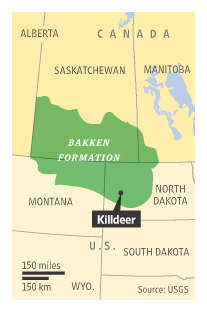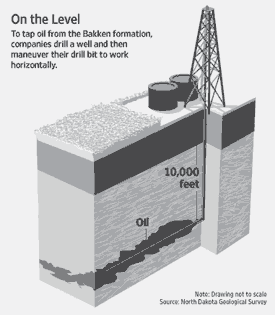redo Jump to...
print Print...
 (by Ben Casselman, The Wall Street Journal, WSJ.com) KILLDEER, N.D. – A massive oil reserve buried two miles underground has put North Dakota at the center of a revolution in the U.S. oil industry, a shift that has radically altered the fortunes of this remote area.
(by Ben Casselman, The Wall Street Journal, WSJ.com) KILLDEER, N.D. – A massive oil reserve buried two miles underground has put North Dakota at the center of a revolution in the U.S. oil industry, a shift that has radically altered the fortunes of this remote area.
The Bakken Shale deposit has been known and even tapped on occasion for decades. But technological improvements in the past two years have taken what was once a small, marginally profitable field and turned it into one of the fastest-growing oil-producing areas in the U.S.
The Bakken Shale had helped North Dakota oil production double in the past three years, surging to 80 million barrels in 2009-tiny relative to the more than seven billion barrels consumed by the U.S. every year, but enough to vault the state past Oklahoma and Louisiana to become the country’s fourth-biggest oil producer, after Texas, Alaska and California. If current projections hold, North Dakota’s oil production could pass Alaska’s by the end of the decade. …
The Bakken Shale could contain up to 4.3 billion barrels of recoverable oil, according to the U.S. Geological Survey. That would make it the biggest oil field discovered in the contiguous U.S. in more than 40 years-and many in the industry believe the amount of recoverable oil could be even greater as new technology allows companies to tap more of it.
U.S. oil production has fallen by nearly 50% since its peak in the 1970s. Even with the Bakken Shale, U.S. oil production isn’t expected to ever return to 1970s levels, and even the most optimistic projections of production from the North Dakota field don’t account for more than a small fraction of total U.S. oil demand. But new production from the Bakken Shale, combined with other big oil discoveries in California and the Gulf of Mexico, helped U.S. oil production rise last year for the first time since 1991, according to U.S. government figures.
Production has grown so rapidly here, 100 miles south of the Canadian border, that companies had to build a rail line to transport their oil to market, since there wasn’t a big enough pipeline in the state to handle the oil. Companies have scrambled to find labor in a state with fewer than a million people, and to keep drilling rigs running when the wind chill pushes temperatures to 50 degrees below zero. Booming Bakken oil production has helped North Dakota escape the worst of the economic downturn. The state’s unemployment rate was 4.3% in December-more than five percentage points below the national level-and the state government projects a surplus for the current budget cycle.
The impact has been especially notable in the oil-producing western part of the state, making millionaires of local ranchers who sell access to oil beneath their properties. Oil-field workers have flooded the western city of Williston, leaving it with a chronic shortage of hotel rooms and making housing scarce. In Dickinson, three hours to the south, a labor shortage has the local McDonald’s offering $300 signing bonuses. And here in nearby Killdeer, a town of 700 people that lies in the heart of oil country, oil workers jockey with locals for lunchtime tables at the Buckskin Bar & Grill, which serves burgers made from locally raised buffalo. …
Pam Reckard, 66, and her husband, Ben, said many locals, having seen past booms and busts, are taking a cautious approach to the region’s newfound oil wealth. The Reckards are still driving their 1990 Dodge pickup despite having two successful oil wells drilled on their 1,120-acre ranch, which Mr. Reckard’s family has owned since 1915. But they have noticed the changes. “There are a lot of people that were not from North Dakota,” Ms. Reckard said.
The industry hopes the Bakken’s significance could extend far beyond North Dakota. The Bakken formation stretches into Montana and across the U.S. border into Saskatchewan. Other oil-bearing shale formations exist in Colorado, Texas, California and other states.
“It’s a true game-changer,” said Jim Volker, chairman and CEO of Whiting Petroleum Corp. a Bakken oil producer. “We still think there’s a significant amount of oil reserves in the United States left to be discovered.” …
Oil companies have known about the formation, and the oil trapped in it, since at least the 1950s. But they couldn’t get more than a trickle of oil from the dense, nonporous rock.
 That began to change in the early 2000s, when companies in Texas began using new drilling techniques in a similar formation near Fort Worth known as the Barnett Shale. They would drill down thousands of feet and then turn and go horizontally through the gas-bearing rock-allowing a single well to reach more gas. Then they would blast huge volumes of water down the well to crack open the rocks and free the gas trapped inside.
That began to change in the early 2000s, when companies in Texas began using new drilling techniques in a similar formation near Fort Worth known as the Barnett Shale. They would drill down thousands of feet and then turn and go horizontally through the gas-bearing rock-allowing a single well to reach more gas. Then they would blast huge volumes of water down the well to crack open the rocks and free the gas trapped inside.
Several companies, including Houston-based EOG Resources Inc., thought the same techniques could work on oil formations. But oil molecules are larger than gas molecules, and they didn’t flow as easily through the cracks. EOG’s first several wells in North Dakota were failures.
“The first three or four wells, it was not clear that there would be a viable economic solution,” EOG Chairman and CEO Mark Papa said. “But we just felt like, well, it’s worth investing $20 to $40 million in this because if it works there’s a huge upside.”
By 2006, EOG was making money on wells drilled in a small corner of the Bakken that was particularly well-suited to oil production.
The real shift has come in the past two years as companies honed drilling techniques, leading to bigger wells, faster drilling and lower costs. Marathon [Oil Corp.], for example, last year took an average of 24 days to drill a well, down from 56 days in 2006.
That has opened up new areas that weren’t previously worth drilling in and made wells profitable at prices as low as $50 a barrel, down from $80 three years ago, according to analyst Mike Jacobs of investment firm Tudor Pickering Holt & Co.
Write to Ben Casselman at ben.casselman@wsj.com.
Copyright 2010 Dow Jones & Company, Inc. All Rights Reserved. Reprinted here for educational purposes only. Visit the website at wsj.com.
Questions
1. a) Name the states that are bigger oil producers than North Dakota.
b) Which states has North Dakota surpassed in oil production recently?
2. By how much has oil production from the Bakken Shale increased in the past three years?
3. a) How much oil does the U.S. consume every year?
b) How many barrels of recoverable oil could the Bakken shale contain?
4. How has oil production helped the citizens of North Dakota?
5. If they have known about the Bakken Shale oil since at least the 1950s, why haven’t oil companies retrieved it?
6. What has really caused the increase in oil production in North Dakota and other places in the past two years?
Background
Oil shale can be mined and processed to generate oil similar to oil pumped from conventional oil wells; however, extracting oil from oil shale is more complex than conventional oil recovery and currently is more expensive. The oil substances in oil shale are solid and cannot be pumped directly out of the ground. The oil shale must first be mined and then heated to a high temperature (a process called retorting); the resultant liquid must then be separated and collected. An alternative but currently experimental process referred to as in situ retorting involves heating the oil shale while it is still underground, and then pumping the resulting liquid to the surface. (Read more at ostseis.anl.gov/guide/oilshale/index.cfm.)
Daily “Answers” emails are provided for Daily News Articles, Tuesday’s World Events and Friday’s News Quiz.



